| Listing 1 - 10 of 27 | << page >> |
Sort by
|
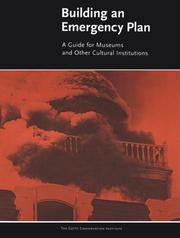
ISBN: 089236551X Year: 1999 Publisher: Getty Publications
Abstract | Keywords | Export | Availability | Bookmark
 Loading...
Loading...Choose an application
- Reference Manager
- EndNote
- RefWorks (Direct export to RefWorks)
Museums --- Emergency management --- Cultural property --- Management --- Planning --- Protection --- Cultural heritage --- Cultural patrimony --- Cultural resources --- Heritage property --- National heritage --- National patrimony --- National treasure --- Patrimony, Cultural --- Treasure, National --- Property --- World Heritage areas --- Public institutions --- Cabinets of curiosities
Book
Abstract | Keywords | Export | Availability | Bookmark
 Loading...
Loading...Choose an application
- Reference Manager
- EndNote
- RefWorks (Direct export to RefWorks)
History --- historic preservation --- museums [buildings] --- Civilisation --- cultural heritage --- Architecture --- History of civilization --- cultuurgeschiedenis --- cultuursociologie --- cultureel erfgoed --- museumkunde --- Museology --- museologie --- identiteit --- Nederland --- Cultural property --- Historic preservation --- Protection --- #VCV monografie 2006 --- #FARO gidsen_museale ontwikkelingen --- Preservation, Historic --- Preservationism (Historic preservation) --- Cultural heritage --- Cultural patrimony --- Cultural resources --- Heritage property --- National heritage --- National patrimony --- National treasure --- Patrimony, Cultural --- Treasure, National --- Property --- World Heritage areas --- Netherlands --- Nederland.
Book
ISBN: 9789056626495 Year: 2008 Publisher: Rotterdam NAi Uitgevers
Abstract | Keywords | Export | Availability | Bookmark
 Loading...
Loading...Choose an application
- Reference Manager
- EndNote
- RefWorks (Direct export to RefWorks)
collection development --- Museology --- collecting --- museums [institutions] --- Netherlands --- Museums --- Cultural property --- Collection management --- Protection --- collectiebeheer --- Nederland --- Public institutions --- Cabinets of curiosities --- Cultural heritage --- Cultural patrimony --- Cultural resources --- Heritage property --- National heritage --- National patrimony --- National treasure --- Patrimony, Cultural --- Treasure, National --- Property --- World Heritage areas --- Nederland.
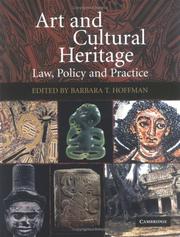
ISBN: 9780521122979 9780521857642 0521857643 Year: 2009 Publisher: Cambridge : Cambridge University Press,
Abstract | Keywords | Export | Availability | Bookmark
 Loading...
Loading...Choose an application
- Reference Manager
- EndNote
- RefWorks (Direct export to RefWorks)
351.852 --- Overheidstaken, administratieve maatregelen i.v.m. musea, verzamelingen, bibliotheken, archieven --- 351.852 Overheidstaken, administratieve maatregelen i.v.m. musea, verzamelingen, bibliotheken, archieven --- Cultural property --- Cultural heritage --- Cultural patrimony --- Cultural resources --- Heritage property --- National heritage --- National patrimony --- National treasure --- Patrimony, Cultural --- Treasure, National --- Property --- World Heritage areas --- Protection&delete& --- Law and legislation --- Art --- Sociology of cultural policy --- Protection --- Patrimoine culturel --- Droit --- Droit international
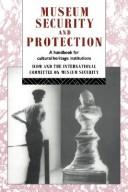
ISBN: 0415054575 0415075092 Year: 1993 Publisher: Londres Routledge
Abstract | Keywords | Export | Availability | Bookmark
 Loading...
Loading...Choose an application
- Reference Manager
- EndNote
- RefWorks (Direct export to RefWorks)
Cultural property --- Museums --- Public institutions --- Cabinets of curiosities --- Cultural heritage --- Cultural patrimony --- Cultural resources --- Heritage property --- National heritage --- National patrimony --- National treasure --- Patrimony, Cultural --- Treasure, National --- Property --- World Heritage areas --- Protection --- Security measures --- museumbeheer --- museum administration --- beveiliging --- cultureel erfgoed --- cultural heritage --- Museology --- security --- Hygiene. Public health. Protection
Book
ISBN: 9780415610469 9780415610452 0415610451 041561046X 0203813758 9780203813751 1136702326 9786613163004 1283163004 1136702318 9781136702273 9781136702310 9781136702327 Year: 2011 Publisher: Abingdon, Oxon : Routledge,
Abstract | Keywords | Export | Availability | Bookmark
 Loading...
Loading...Choose an application
- Reference Manager
- EndNote
- RefWorks (Direct export to RefWorks)
Visitors to museums, galleries, heritage sites and other not for profit attractions receive their information in changing ways. Communications channels are shifting and developing all the time, presenting new challenges to cultural PR and Marketing teams. Marketing and Public Relations for Museums, Galleries, Cultural and Heritage Attractions, as well as providing some of the theory of marketing, provides the latest available case studies coupled with comments and advice from professionals inside and outside the cultural sector to describe the possibilities and outline strategies.
Marketing --- Museology --- Advertising. Public relations --- Museums --- Arts --- Cultural property --- Musées --- Biens culturels --- Marketing. --- Public relations. --- Public relations --- Relations publiques --- Commercialisation --- museumbeleid --- cultuurbeleid --- publiekswerking --- #SBIB:316.7C323 --- #SBIB:316.7C324 --- #SBIB:309H2812 --- Cultural heritage --- Cultural patrimony --- Cultural resources --- Heritage property --- National heritage --- National patrimony --- National treasure --- Patrimony, Cultural --- Treasure, National --- Property --- World Heritage areas --- Arts, Fine --- Arts, Occidental --- Arts, Western --- Fine arts --- Humanities --- Public institutions --- Cabinets of curiosities --- Culturele infrastructuur: tentoonstellingsruimten --- Culturele infrastructuur: musea --- Marketing, consumentengedrag, consumentisme --- Musées --- Arts, Primitive --- museumbeleid. --- cultuurbeleid. --- publiekswerking.
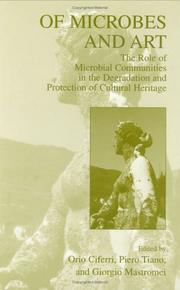
ISBN: 0306463776 1461369045 1461542391 Year: 2000 Publisher: New York [etc.] Kluwer Academic/Plenum Publ.
Abstract | Keywords | Export | Availability | Bookmark
 Loading...
Loading...Choose an application
- Reference Manager
- EndNote
- RefWorks (Direct export to RefWorks)
Microbial defacement and degradation of artistic or historic artifacts is a worldwide problem affecting all countries regardless of their history, geographical location, or economic conditions. This is the first comprehensive study of the role of microbial colonization on the degradation of different cultural artifacts (from buildings to books, wall paintings, textiles, sculptures and glass) and of the investigations into the compounds utilized to control microbial invasion. The book focuses on three main areas: the identification of the microorganisms which cause structural damage; methods to reduce or prevent microbial colonization and damage; and the use of microorganisms for the protection and bioremediation of cultural artifacts.
Art objects --- Biodegradation --- Materials --- Conservation and restoration --- Archaeology. --- Cultural heritage. --- Plant science. --- Botany. --- Mineral resources. --- Cultural Heritage. --- Plant Sciences. --- Mineral Resources. --- Deposits, Mineral --- Mineral deposits --- Mineral resources --- Mines and mining --- Mining --- Natural resources --- Geology, Economic --- Minerals --- Botanical science --- Phytobiology --- Phytography --- Phytology --- Plant biology --- Plant science --- Biology --- Natural history --- Plants --- Cultural heritage --- Cultural patrimony --- Cultural resources --- Heritage property --- National heritage --- National patrimony --- National treasure --- Patrimony, Cultural --- Treasure, National --- Property --- World Heritage areas --- Archeology --- Anthropology --- Auxiliary sciences of history --- History --- Antiquities --- Floristic botany
Book
ISBN: 9072905164 9789072905161 Year: 1992 Volume: 10 Publisher: Amsterdam Centraal Laboratorium voor Onderzoek van Voorwerpen van Kunst en Wetenschap
Abstract | Keywords | Export | Availability | Bookmark
 Loading...
Loading...Choose an application
- Reference Manager
- EndNote
- RefWorks (Direct export to RefWorks)
museology --- Museology --- Museums --- Cultural property --- Security measures --- Protection --- 069.01 --- 022.2 --- -Museums --- -Public institutions --- Cabinets of curiosities --- Cultural heritage --- Cultural patrimony --- Cultural resources --- Heritage property --- National heritage --- National patrimony --- National treasure --- Patrimony, Cultural --- Treasure, National --- Property --- World Heritage areas --- Museologie --- Bibliotheekgebouwen: bouwmaterialen; beveiliging van bibliotheken; beheer en onderhoud --- -Museologie --- 022.2 Bibliotheekgebouwen: bouwmaterialen; beveiliging van bibliotheken; beheer en onderhoud --- 069.01 Museologie --- -022.2 Bibliotheekgebouwen: bouwmaterialen; beveiliging van bibliotheken; beheer en onderhoud --- Public institutions --- -Cultural heritage
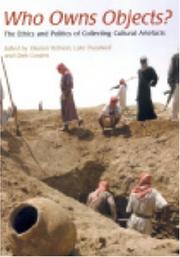
ISBN: 1842172336 9781842172339 Year: 2006 Publisher: Oxford : Oxbow Books,
Abstract | Keywords | Export | Availability | Bookmark
 Loading...
Loading...Choose an application
- Reference Manager
- EndNote
- RefWorks (Direct export to RefWorks)
Conferences - Meetings --- Archaeological thefts --- Repatriation --- Acquistions --- Cultural property --- Excavations (Archaeology) --- Museums --- Archaeological digs --- Archaeological excavations --- Digs (Archaeology) --- Excavation sites (Archaeology) --- Ruins --- Sites, Excavation (Archaeology) --- Archaeology --- Cultural heritage --- Cultural patrimony --- Cultural resources --- Heritage property --- National heritage --- National patrimony --- National treasure --- Patrimony, Cultural --- Treasure, National --- Property --- World Heritage areas --- Antiquities --- Archaeological theft --- Theft --- Public institutions --- Cabinets of curiosities --- Protection --- Moral and ethical aspects --- Thefts --- Industrial and intellectual property --- General ethics --- Archeology
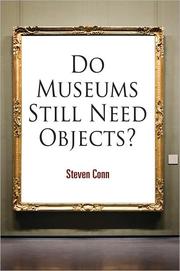
ISBN: 9780812241907 0812241908 0812201655 0812221559 1283890003 Year: 2010 Publisher: Philadelphia : University of Pennsylvania Press,
Abstract | Keywords | Export | Availability | Bookmark
 Loading...
Loading...Choose an application
- Reference Manager
- EndNote
- RefWorks (Direct export to RefWorks)
"We live in a museum age," writes Steven Conn in Do Museums Still Need Objects? And indeed, at the turn of the twenty-first century, more people are visiting museums than ever before. There are now over 17,500 accredited museums in the United States, averaging approximately 865 million visits a year, more than two million visits a day. New museums have proliferated across the cultural landscape even as older ones have undergone transformational additions: from the Museum of Modern Art and the Morgan in New York to the High in Atlanta and the Getty in Los Angeles. If the golden age of museum-building came a century ago, when the Metropolitan Museum of Art, the American Museum of Natural History, the Philadelphia Museum of Art, the Field Museum of Natural History, and others were created, then it is fair to say that in the last generation we have witnessed a second golden age.By closely observing the cultural, intellectual, and political roles that museums play in contemporary society, while also delving deeply into their institutional histories, historian Steven Conn demonstrates that museums are no longer seen simply as houses for collections of objects. Conn ranges across a wide variety of museum types-from art and anthropology to science and commercial museums-asking questions about the relationship between museums and knowledge, about the connection between culture and politics, about the role of museums in representing non-Western societies, and about public institutions and the changing nature of their constituencies. Elegantly written and deeply researched, Do Museums Still Need Objects? is essential reading for historians, museum professionals, and those who love to visit museums.
Museology --- Museums --- Museum exhibits --- Cultural property --- Art objects --- Musées --- Objets exposés --- Biens culturels --- Objets d'art --- History --- Collection management --- Political aspects --- Social aspects --- Histoire --- Gestion des collections --- Aspect politique --- Aspect social --- museum --- museologie --- Musées --- Objets exposés --- History. --- Political aspects. --- Public institutions --- Cabinets of curiosities --- Display techniques --- Displays, Museum --- Museum displays --- Exhibitions --- Museum techniques --- Cultural heritage --- Cultural patrimony --- Cultural resources --- Heritage property --- National heritage --- National patrimony --- National treasure --- Patrimony, Cultural --- Treasure, National --- Property --- World Heritage areas --- Bric-a-brac --- Objects, Art --- Art --- Decoration and ornament --- Decorative arts --- Object (Aesthetics) --- Antiques --- American History. --- American Studies. --- Cultural Studies.
| Listing 1 - 10 of 27 | << page >> |
Sort by
|

 Search
Search Feedback
Feedback About
About Help
Help News
News